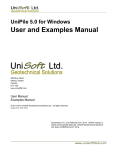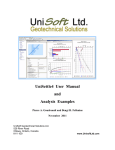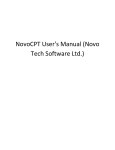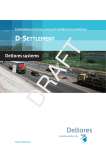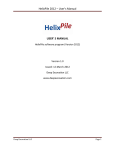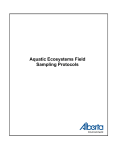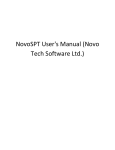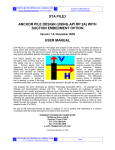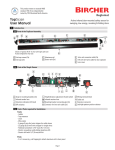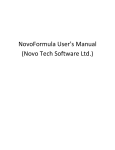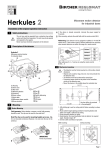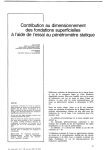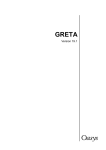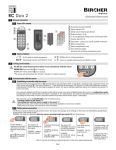Download User Manual - UniSoft Geotechnical Solutions Ltd
Transcript
UniPile 5.0 for Windows User Manual 528 River Road Ottawa, Ontario Canada K1V 1E9 www.unisoftgs.com © 2011-2015 UniSoft Geotechnical Solutions Ltd. All rights reserved. Version 5.05: 2/9/2015 3:02:22 PM TABLE OF CONTENTS PART I 1.0 INTRODUCTION .......................................................... .......................................................... .......................................................... .......................................................... .......................................................... .......................................................... 5 5 6 2.0 WHAT'S NEW .......................................................... 7 3.0 USING UNIPILE 3.1 Definitions .......................................................... .......................................................... 8 8 3.2 Navigating UniPile 5.0 3.3 Data Menu .......................................................... .......................................................... 11 11 3.4 Entering Data .......................................................... 14 .......................................................... .......................................................... 17 17 4.2 Using the Demo Examples 4.3 Open Project 4.4 Recent Projects 4.5 Selecting Units 4.6 Viewing Design Data 4.7 View Site Plan 4.8 Perform an Analysis 4.9 Review Results .......................................................... .......................................................... .......................................................... .......................................................... .......................................................... .......................................................... .......................................................... .......................................................... 4.10 Chart Results 4.11 Save Data 4.12 Print Data and Results .......................................................... .......................................................... .......................................................... 17 18 19 20 20 21 24 24 27 29 5.0 IMPORTING AND EXPORTING 5.1 Importing UniPile 4.0 Files 5.2 Importing UniSoft XMLU Files 5.3 Importing UniSettle 4.0 Files .......................................................... .......................................................... .......................................................... .......................................................... 5.4 Import SPT, CPT/CPTU Data 5.5 Export to XMLU File 5.6 Export Site Plan to Bitmap 5.7 Export Results to Excel .......................................................... .......................................................... .......................................................... .......................................................... 1.1 Welcome 1.2 Technical Support 1.3 Recommended System Requirements 1.4 Example Files 1.5 Activating UniPile 5.0 4.0 YOUR FIRST ANALYSIS 4.1 New Project Page 2 of 67 6 6 6 30 31 31 32 32 32 34 34 34 .......................................................... .......................................................... 35 .......................................................... .......................................................... .......................................................... .......................................................... .......................................................... .......................................................... 36 36 36 36 36 36 7.1 Project 7.2 Client 7.3 Engineer .......................................................... .......................................................... .......................................................... .......................................................... 37 37 37 38 7.4 Custom .......................................................... 38 8.0 SETTINGS 8.1 General Settings 8.2 General Analysis 8.3 Residual Load 8.4 Loading Test Simulation 8.5 Analysis Options .......................................................... .......................................................... .......................................................... .......................................................... .......................................................... .......................................................... 39 39 9. DEPTH POINTS .......................................................... .......................................................... 43 43 .......................................................... .......................................................... .......................................................... .......................................................... .......................................................... 44 44 45 46 11. PILE GROUP DATA 11.1 General 11.2 Properties 11.3 Geometry .......................................................... .......................................................... .......................................................... .......................................................... 50 50 12. SOIL LAYERS .......................................................... 52 52 53 5.8 Export Results to Text File 5.9 Export Chart to Bitmap 6.0 ADMINISTRATION 6.1 User Preferences 6.2 Check for New Update 6.3 Register UniPile 6.4 Activate UniPile 6.5 Advanced 35 PART II 7.0 PROJECT INFORMATION 9.1 Additional Depths 10. PILE DATA 10.1 General 10.2 Resistance Parameters 10.3 Geometry 10.4 User Defined Longitudinal Profile 12.1 General 12.2 Resistance Parameters .......................................................... .......................................................... Page 3 of 67 39 40 41 42 48 50 51 12.3 Resistance vs. Movement 12.4 Compressibility 13. PORE PRESSURE 13.1 General 13.2 Hydrostatic Profile 13.3 Non-Hydrostatic Profile 14. SPT, CPT/CPTU Data 14.1 General 14.2 Standard/Cone Penetration Data 15. LOADS AND EXCAVATIONS 15.1 General 15.2 Geometry 16. T-Z/Q-Z FUNCTIONS .......................................................... .......................................................... 54 54 .......................................................... .......................................................... .......................................................... .......................................................... 57 57 57 58 .......................................................... .......................................................... .......................................................... 59 59 59 .......................................................... .......................................................... .......................................................... 61 61 62 .......................................................... 16.1 General 16.2 Model Parameters .......................................................... .......................................................... 64 64 65 17. USER PREFERENCES .......................................................... 67 Page 4 of 67 PART I (Sections 1 through 6) 1.0 INTRODUCTION 1.1 Welcome Welcome to UniPile 5.0 for Windows 7, a software for the design of piles and pile groups according to various design methods. UniPile produces analysis of pile capacity, pile settlement (single and group), negative skin friction, drag force, and downdrag along with aspects of drivability and residual load. It will also simulate the load-movement response of the pile in a static loading test—Head-Down and Bidirectional Cell. The documentation for UniPile 5.0 comes in four separate documents: 1. This user manual to help you navigate the many features of the software. 2. A document entitled Getting Started describing how to setup, upgrade, register, and activate UniPile 5.0. 3. An examples manual describing the various example files provided with the software. 4. The "Red Book", a text book called "Basics of Foundation Design" by Bengt H. Fellenius, Dr. Tech., P.Eng., which addresses settlement analysis, piled foundations, footings, retaining walls, and vertical drain projects, supplementing (but not replacing) conventional and more comprehensive geotechnical textbooks. This document is not provided with the software, but may be downloaded free of charge by visiting: http://www.unisoftgs.com/Uploaded/downloads/RedBook.pdf. Important The purpose of this user manual is not to teach or to educate engineers on the many concepts related to pile design and geotechnical engineering in general. We assume that our users are well experienced in the design of piles and deep foundation in general. UniPile 5.0 is available in many modes: Demo, Educational, Basic, Standard, and Professional. Depending on the type of version you are running, some of the features described in this manual may be disabled. From time to time, we also issue updates to correct minor issues or add new features. Slight differences may exist between the images shown in this document and the version that is running on your computer. This application has many features and hoping to learn them all in a single reading is unrealistic. Part I of this user manual refers to the use of the software in general terms. Part II describes the input variables used throughout the application. If your copy of the software is already installed, activated, and ready to go, we suggest that you jump straight to Section 3.0 - Using UniPile. If you are anxious to perform an analysis immediately, jump to Section 4.0 - Your First Analysis. Page 5 of 67 1.2 Technical Support Free limited technical support regarding the use of all our products may be obtained by contacting us at [email protected]. We also suggest that you regularly consult our website at www.unisoftgs.com. It provides many technical papers and FAQs that may already have the answer to your question. Before contacting us, please make sure that you are using the latest release of the product as we correct and release updates as issues are reported. Also, please have your serial number available. It is shown in the "About" window located under the main "Help" menu. 1.3 Recommended System Requirements UniPile 5.0 was developed specifically for the Microsoft Windows 7 environment. It has however been tested on earlier versions of Microsoft Windows Vista, Windows XP (SP3), and Windows 2000. In that respect, UniPile 5.0 requires Microsoft.Net Framework Version 3.5 SP1 or above. Microsoft.Net Framework comes pre-installed with Microsoft Windows 7. For earlier versions of Microsoft Windows, you may be required to download and install Microsoft.Net Framework prior to resuming the installation of UniPile 5.0. Microsoft.Net Framework is a component developed and maintained by Microsoft Corp. It is free for all registered users of Microsoft Windows. 1.4 Example Files If you selected this option during the setup process, a series of example files were installed in the "My Documents\UniPile 5.0\ Example Files" folder created under the current user documents folder. If the application was installed on a server, the network administrator will be required to move these files manually to provide access to all users. Alternatively, the same example files may be obtained by visiting the download section of our website at www.unisoftgs.com. 1.5 Activating UniPile 5.0 All UniSoft products are copy-protected using activation code technology. When you purchased UniPile 5.0, you were provided with a unique serial number and activation code to unlock your copy of the software. Activation of your licence is performed via the "Activate ..." feature located under the main "Administration" menu. Detailed information on how to register and activate UniPile 5.0 is available in our Getting Started document. Page 6 of 67 2.0 WHAT'S NEW Now 32-bit UniPile 5.0 is now a 32-bit compiled application. It is fully compatible with Microsoft Windows XP (SP3), Windows Vista and 2000, Windows 7, and Windows 8 (both 32-bit and 64-bit versions). New input and results windows We have developed a new look for all input and results windows. These were designed to simplify data entry and facilitate navigation between various components and results. Janbu and conventional method Pile and pile group settlement may now be calculated based on either Janbu or conventional parameters. Input conversion to Janbu parameters is no longer required. Loads and excavations Two new load types have been introduced: full and half embankments. Loads and excavation need no longer to be concentric with the pile analyzed, which allows designing for a more realistic environment. Stress analysis Calculation of stresses and settlements may now be performed using Boussinesq, Westergaard, or 2:1 stress distributions. Pile resistance analysis Pile ultimate resistance and load distribution may be calculated using: (1) Static method (Beta or Alpha), CPTU-method (Eslami and Fellenius) (2) CPT-methods (Schmertmann and Nottingham, deRuiter and Beringen, and Bustamente-LCPC) (3) SPT N-indices methods (Meyerhof, Decourt, and O'Neill-Reese) The results CPTU and CPT methods automatically show the equivalent ß-coefficients. Bidirectional cell loading test simulation In addition to the Head-Down static loading test, UniPile now also performs a Bidirectional-Cell loading test simulation. Multiple t-z and q-z functions Pile Resistance-Movement (t-z and q-z) functions for simulation of the static loading test include Ratio, Hyperbolic (Chin-Kondner), Exponential, Hansen 80%, Zhang, and a user defined model. Page 7 of 67 3.0 USING UNIPILE We tried hard to ensure UniPile 5.0 is intuitive for most engineers. This section provides a quick overview of what you need to know before beginning. 3.1 Definitions Using computer and software terms is no different than using geotechnical terms. Learning and using the correct ones on a consistent basis should help you learn to use our products faster. The following definitions are used throughout this manual. Interface The interface is the means of communication between the user and the software. It is the sum of all the visible parts of the software. The image below represents UniPile 5.0’s interface. It includes the main menu, buttons, and windows. Toolbar A toolbar is a graphic user interface component upon which menus, buttons, icons or other input or output elements are placed. Page 8 of 67 Menu and sub-menu A menu is a list of commands usually presented at the top of the interface or at the top of individual windows. Menus are often hierarchically organized, allowing navigation through different levels of the menu structure. Selecting a menu entry should result in an action or provide another list of options. The latter is referred to as a sub-menu. Popular menu items are often presented as buttons on toolbars. This saves the user time by allowing quick access to frequently-used actions. Button In computing terms, a button is a user interface element that provides the user with a simple way to trigger an event. Selecting a button should result in an action or, in the case of a drop-down button, provide a list of available options. Buttons are often an iconic representation of the most popular menu options. They may also contain short text commands such as "OK", "Cancel", or "Proceed". Buttons located on toolbars are usually a repeat of the most frequently used menu items. Page 9 of 67 Drop-down box A drop-down box is a commonly-used graphical user-interface component. It may be a combination of a drop-down list or list box and a single-line textbox, allowing the user to either type a value directly into the control or choose from the list of items. In UniPile 5.0, design units are selected from a drop-down box displayed on the main toolbar. Data tree A data tree is a widely-used method to display inter-related data. It emulates a hierarchical tree structure with a set of linked nodes. In UniPile 5.0, a data tree is used to access every data form available. The main advantage of a data tree is that it makes information visible and readily available rather than having to navigate complicated menu structures. If you have used Microsoft Windows Explorer or Microsoft Windows Outlook in the past, you are likely very familiar with data trees. One of the most powerful features of the data tree is that long lists of components may be individually collapsed or expanded by clicking on the + or - sign located on the left side of a heading. The various features of the data tree used in UniPile are discussed in Section 3.2 - Navigating UniPile 5.0. Windows or forms In a Microsoft Windows compatible application, windows are used to display textual and graphical information. In UniPile 5.0, windows (or forms) are used to enter general data, soil properties, loads and excavations, display results, display messages, etc. This document assumes that you have prior experience with other Microsoft Windows products and that you are already familiar with the many features attached to windows such as opening, moving, resizing, and closing. Component This manual uses the term component to describe groups of data of the same type. For example, all soil layers are individual components of the same type. Loads and excavations are also components but of different types. Page 10 of 67 3.2 Navigating UniPile 5.0 In an effort to make the software more powerful and versatile, the navigation between various input windows is now performed via the main data tree. The data tree is a powerful tool as it allows the user to display and access a large number of items. The data tree is also context sensitive, a term meaning that the various menu options available at any given time might vary depending on the item currently selected. The following image shows the data tree for a project having three soil layers. Selecting any soil layer from the list (e.g., "Clay") will display the input data specific to the layer. Similarly, selecting any other item from a list will display the input data specific the item. 3.3 Data Menu The main "Data" menu is used to add, delete, copy, paste, move, expand, and collapse the various components of the data tree. It is directly related to the context sensitive feature of the data tree. In other words, the options presented under the main "Data" menu are dynamic and will change according to the data tree item selected. This also means that the "Data" menu may be accessed directly by clicking the right mouse button on a selected data tree item. The following sample image shows the list of options under the main "Data" menu when the "Clay" soil layer is selected. Many of the options presented under the main "Data" menu are also available as buttons on the secondary toolbar. The role of each feature is explained below. Page 11 of 67 The following section describes the various features of the "Data" menu, and assumes that a soil layer component has been selected. Some of these features may read differently or be disabled altogether if a different component is selected. However, the concept remains the same. View/Edit Soil Layer This option is the equivalent of a double click in a data tree item. It will bring the selected input window (or form) to the forefront of the interface. Previous Forces the selection of the item appearing just above the item currently selected. For example, if the second soil layer is currently selected, selecting this option will move the focus and display the input data related to the first soil layer. Next Forces the selection of the item appearing just below the item currently selected. For example, if the last soil layer is currently selected, selecting this option will move the focus to the "Initial Pore Pressure" item of the data tree. Add New Soil Layer Use this option to add a new component to the project. Depending on the current selection, this feature is also updated and used to add new soil layers, loads, excavations, or t-z/q-z functions. Components may only be added one at a time. Components are always added to the bottom of the list. Page 12 of 67 Tip To insert a new soil layer between two existing layers, use the "Add New Soil Layer" option in conjunction with the "Move Up" command discussed below. Delete Soil Layer Use this option to delete an existing component of the project. Depending on the current selection, this feature may be used to delete an existing soil layer, load, excavation, or t-z/q-z function. Multiple components of the same group may be deleted at once. To select a series of components, click on the items while holding your keyboard Shift key. Use caution when deleting components. Once deleted, components cannot be retrieved via an undo command. Tip To de-select a group of items, simply release the Shift key and select any single item again. Copy Soil Layer Use this option to copy individual component data into the application memory. The data in memory may be pasted into another component of the same kind later. Depending on the current selection, this feature may only apply to soil layers, loads, excavations, and t-z/q-z functions. “Copy” is used in conjunction with the "Paste" command and has no use outside the application. Paste Soil Layer Use this option to apply the contents of the memory to a specific component of the same kind. Pasting data amounts to replacing the currently selected group of data with the data in memory. “Paste” is used in conjunction with the "Copy" command and is most useful to repeat the input of similar components. Move Up / Move Down Use these two commands to revise the order of the selected item inside the data tree. Moving soil layers up or down the list will affect the results as soil layers are assumed to be in the order in which they appear. Tip Use the "Move Up" command in conjunction with the "Add New Soil Layer" option to insert a new soil layer between two existing soil layers. Expand All One of the best features of the data tree is that long lists of components may be individually collapsed or expanded by clicking on the + or - sign located on the left side of a heading. In addition, the complete tree may be expanded by selecting the "Expand All" command. Individual items may then be collapsed by clicking the - sign located on the left side of the heading. Collapse All This command acts opposite to the "Expand All" command. It collapses the entire tree to a minimum number of items. Individual items may then be expanded by clicking the + sign located on the left side of the heading. Page 13 of 67 3.4 Entering Data In an effort to provide consistency and to facilitate the use of the software, all input windows use an Excel-type grid and cell system. The following image uses the "User Preferences" window to describe some of the features applicable to most input windows. User preferences may be accessed from the main "Administration" menu, and are discussed in greater detail in Section 17.0 - User Preferences. Group heading The group heading is used to describe a related set of input data. This heading is fixed and cannot be edited or changed. As with the data tree, group headings may be collapsed or expanded using the + or - signs located on the left. Variable name The variable name is a short reference to the specific variable under consideration. When selecting a row, the specific variable and a short definition will appear at the bottom of the window. The variable name is fixed and cannot be edited or changed. Description The bottom of the window provides a short definition and relevant information regarding the variable under consideration. This description is fixed and cannot be edited or changed. Input cells Input cells are on the right side of each variable name. There are 3 types of input cells: regular, drop-down, and button. Once selected, input cells behave differently depending on their type. Navigation between input cells is performed using the mouse cursor or the keyboard’s Up or Down arrow keys. Page 14 of 67 Regular input cell This is the most common type of input cell used throughout the application. It was designed to behave as a Microsoft Excel spreadsheet cell. Once it has been selected, the cell may be edited by typing, pressing the keyboard’s F2 key, or double-clicking the left mouse button. Editing is cancelled using the keyboard’s Esc key or recorded by pressing the keyboard’s Enter key or moving to another cell. Drop-down input cell A drop-down input cell is recognized by the downward arrow (a triangle with its apex pointing downward) located on the right side of the cell. It usually provides the user with a list of items to choose from. This type of cell is edited by pressing the keyboard’s F2 key or by clicking the left mouse button on the downward arrow. Editing is cancelled using the keyboard’s Esc key or recorded by pressing the keyboard’s Enter key. Some drop-down input cells will only allow selection from a pre-determined list. Others will allow you to enter and select your own content. An example of a drop-down input cell may be found in the "Display Units" input located in the "User Preferences" window. Page 15 of 67 Button input cell When it has the focus, a button input cell is recognized by the ellipsis button (...) located on the right side of the cell. When activated, this feature will provide a new input window, allowing you to complete the editing. This type of cell may be edited by pressing the keyboard’s F2 key or by clicking the left mouse button on the ellipsis button. The "Project Folder" input located in the "User Preferences" window is an example of a button input cell. When selected, it will display a browser window which allows the user to select the folder of his/her choice. Page 16 of 67 4.0 YOUR FIRST ANALYSIS If you have read the previous sections of this document, you should now be up and running and have a better understanding of the interface. However, you still have not used the software for its intended purposes. This section will guide you through the steps necessary to perform your first analysis. 4.1 New Project When starting a new project, we recommend that you access the "New Project" command located under the main "File" menu. Doing so will reset your entire application to the original defaults. On engaging this feature, if the current file was is modified and not yet saved, you will be offered the option to save, skip or cancel. When selecting a new project, your interface will revert back to the original defaults and preferences. Some of these preferences may be customized to your specific needs. In order to do this, access the "User Preferences" command located under the main "Administration" menu.. 4.2 Using the Demo Examples As part of the setup process, you had the option of installing a series of example files that may be used for educational purposes. If you elected to do this, these example files were installed in the "UniPile 5.0 Example Files" folder created under the current user document folder. If the application was installed on a server, the network administrator may need to move these files manually to provide you with access. The examples provided with the application were designed to cover a large range of conditions. Note that if you are using a Demo version, you will not be able to save and will be limited with what you may change. Nonetheless, the example files are a great tool which will assist you in learning the various features of the software as well as many geotechnical concepts. Alternatively, if these example files were not installed as part of the original setup, you may obtain them by visiting the download section of our website at www.unisoftgs.com. Page 17 of 67 4.3 Open Project To open a new project already residing on your system, access the "Open Project" command located under the main "File" menu. A browser window showing the contents of your computer and other connected drives should appear. UniPile 5.0 project files have by default the .UniPile5 file extension. Once you find the project you are looking for, simply bring it in by clicking the "Open" button. Page 18 of 67 If the process was successful, the interface and the data tree will automatically be updated to display the latest set of data of the imported file. Important In many versions of Windows, file extensions are hidden by default. If this occurs, you may not be able to correctly identify UniPile 5.0 project files. If this is the case, we recommend that you contact your network administrator. Important Only project files previously created with UniPile 5.0 may be opened in this fashion. If you are a registered user of UniPile 4.0, you may import UniPile 4.0 project files (.unp) using the "Import" feature. Importing other file formats is discussed in Section 5.0 - Importing and Exporting. 4.4 Recent Projects Project files may also be accessed via the "Recent Projects" feature located under the main "File" menu. UniPile 5.0 records and keeps a list of the projects previously worked on (up to 25). One of the advantages of this feature is that it provides you with more information than simply a file name. For a selected project file, it will display project and client information such as name, number, description, contact, address, and the full path of the project file in your system. The bulk of the information displayed in this window is obtained from the "Project Information" window which is discussed in Section 7.0 - Project Information. The "Remove Item" and "Remove All" options allow you to delete and maintain the project list. Selecting "Open" will open the selected project in UniPile. Page 19 of 67 The list of projects is unique to each user account. Opening a project on an instance of the application on your laptop would not affect the list of projects on an other instance of the application. Important Although a project may appear on the list, it may not be available for you to open. Such would be the case if the file has been renamed, moved, or deleted or if the file was located on a separate drive or server that is currently unavailable. 4.5 Selecting Units The first action one typically completes before entering data is selecting the system of units. With UniPile 5.0, this feature consists of a drop-down box conveniently placed in the main tool bar. Two systems of units are available: The International System of Units (SI) and the US Customary Units. One of the best features of UniPile 5.0 is that the system of units may be switched on the fly at any time. This applies to both the data and the results. For example, some of the input may be made in SI-units, while others may be input in US Customary Units(after switching to US units). Once the analysis is concluded, the results and charts may be converted back-and-forth between either system with a single click. Important To avoid leakage errors due to multiple conversions effected on the same data, UniPile performs what is known as hard conversion. This means that data are converted, kept in memory, saved, and calculated with a high level of precision. However, when displayed on screen, they may be subjected to rounding to a lower level of precision. For example, entering a 10-foot thick soil layer would be internally converted to 3.048 metres; however, it would be rounded to 3.05 metres when displayed. 4.6 Viewing Design Data Also new to UniPile 5.0 is the way in which design data are accessed and presented. No longer are they hidden under a series of menus. All input windows relating to your current project are listed in the data tree located on the left side of the interface. For example, to view the input window for the Initial Pore Pressure, simply click the related entry from the data tree. Page 20 of 67 The data tree combined with the "Data" menu provide an efficient way to navigate, edit, add, and delete input data. Refer to Section 3.0 - Using UniPile for more information regarding various features of the data tree. 4.7 View Site Plan When dealing with multiple coordinates, even small mistakes may result in the most severe consequences. In order to assist the engineer, a bird’s eye view of the site under consideration is produced by accessing the main "Site Plan" menu. In addition, the site plan may be printed or exported to a bitmap file. Additional information may be found in Section 4.12 - Print Data and Results and Section 5.6 - Export Site Plan to Bitmap. Page 21 of 67 The site plan window has its own toolbar displaying a series of options used to customize the view. Some of these options are used to modify the behaviour of the cursor, or to change the scale and the extent of the drawing, while others are used to customize the contents of the drawing. These options are described and discussed below. Default cursor Many of the options associated with the site plan will change the way the cursor reacts when moved over the image. Use this button to return the cursor back to its default state and reset other features. Pan image Panning (in computer terms) enables you to move the image both horizontally and vertically by holding down the left mouse button. Panning is equivalent to moving the image using the vertical and horizontal scroll bars located at the right and bottom of the view. Select the default cursor button to return it to its default behaviour. Important Panning may only work when the image has previously been zoomed and the extent of the image is beyond the edge of the view. Mouse button zoom When enabled, it allows the user to zoom in or out of the image by clicking on the left or right mouse buttons, respectively. Select the default cursor button to return it to its default behaviour. Area zoom When selected, this option allows you to zoom the image in a specific rectangular area. To do this, move the cursor to one corner of the area you want to enlarge. While holding down the left mouse button, move the cursor to create a rectangle around the area you wish to enlarge. Release the mouse button. Select the default cursor button to return it to its default behaviour. View full image Resets the image zoom so the full image (the width and the height) fits inside the current view. Page 22 of 67 View full width Resets the image zoom so the width fits inside the current view. View full height Resets the image zoom so the height fits inside the current view. Site plan options This is a drop-down button which allows you to dictate the contents of the site plan. Specific items may be selected (checked) or de-selected (unchecked). Use these options to hide or display the loads, excavations, mesh points, their coordinates, the (0,0) origin, or the construction history via the "Show History" option. Time period This feature allows you to show the various site conditions at initial and final condition. Assuming that various loads and excavations were set to apply at various time periods, you may use this option to display only the components applicable up to that time period. Important This feature works in conjunction with the "Show History" option located under the "Site plan options". When "Show History" is selected, the loads and excavations displayed will be those applicable up to the selected period (i.e. inclusive). When de-selected, the loads and excavations displayed will only be those applicable to the selected period (i.e. exclusive). Redraw Use this feature to redraw the site plan. This is a rapid way to reset the drawing to its full view. Page 23 of 67 Tip By default, loads appear in light blue while excavations appear in light red with a certain level of transparency. This feature results in overlapping loads and excavations of a darker tone. 4.8 Perform an Analysis Technically, if you have just created a new project and have not yet entered any data or information, you should still be able to perform an analysis. If this is the case, you will be presented with a complete set of results indicating 0. For the purposes of learning UniPile however, it is recommended that you open one of the example projects installed at setup. Your first analysis is initiated by accessing the "Analyze" command located under the main "Analysis" menu. The time required to complete the analysis depends on multiple factors, including the speed of your processor, the depth of the soil profile, the number and size of the loads and excavations, and the many options selected. After a few projects, you will learn to negotiate and compromise between pushing the application to its limits versus using the time necessary to perform complicated analyses. 4.9 Review Results If your analysis was successfully completed, you will be presented with a results table displaying the total compression of each soil layer. Other results may be displayed by accessing the main "Results" menu. Page 24 of 67 Additionally, the secondary toolbar may be updated with a series of drop-down boxes meant to display other sets of results applying to the same topic. The image presented above displays the options available when the total stresses results are displayed. Use the drop-down boxes to change the set of results on the fly. All results produced by UniPile may be exported as a group to an Excel file or as individual results to an ASCII text file for further editing and manipulation. Refer to Section 5.0 - Importing and Exporting for more details on how to export results. The Professional version of UniPile produces 13 different results topics. These are discussed below. Most results may also be displayed in chart format. The features affecting the charts are discussed in Section 4.10 - Chart Results. Analysis Summary This is a quick overview of the pile resistance and settlement obtained as a result of the analysis. Pile Ultimate Resistance, Ru This table reports on the pile ultimate (shaft and toe) resistance—pile capacity. Shaft Resistance, Rs Report a breakdown of the many parameters used in the calculation of the shaft resistance. The extent of this table depends on the selected pile resistance method. Toe Resistance, Rt Present a breakdown of the many parameters used in the calculation of the toe resistance. The extent of this table depends on the selected pile resistance method. Embedment Analysis (WEAP) Present the results of a static soil resistance for an array of depths. Typically these results may be exported to Excel or a text file to facilitate input into the GRLWEAP software. Page 25 of 67 Neutral Plane Analysis Report on the pile factor of safety and the depth of the neutral plane for an array of dead load. Pile Settlement and Compression Present the calculations of the expected long-term pile compression and consolidation settlement (in the vicinity of the pile) caused by the pile group. This analysis assumes equilibrium (i.e. no pile/soil differential settlement) at the location of the neutral plane. Residual Load Report on the residual load profile calculated from the % of shaft and toe mobilization specified. If enabled, the false resistance will be included in the loading test simulation. Head-Down Loading Test Simulation Report on the load-movement curve simulating a head-down static loading test to soil failure. This simulation is based on the t-z/q-z curves describing the stress-movement behaviour of the soil along the pile shaft and at the toe of the pile. Bidirectional Loading Test Simulation Report on the load-movement curve simulating the Bidirectional Cell) static loading test. This simulation is based on the t-z/q-z curves describing the stress-movement response of the soil along the pile shaft and at the pile toe. Effective Stresses Effective stress provides a compilation of the total stress, pore pressure, and effective stresses used in the analysis. Total Stresses Total stress provides a breakdown compilation of the stresses for a specific component. The results may be modified to display the stresses caused by a specific soil layer, load, or excavation. Pile Profile This table represents the various pile properties used throughout the analysis. Page 26 of 67 4.10 Chart Results Most results can be presented in chart format. This provides a good way to quickly demonstrate the behaviour and tendency of the results. The results displayed can be charted by accessing the "Chart Results" option located under the main "Results" menu. In addition, all charts may be printed or exported to a bitmap file. The image below shows a graphic representation of the pile ultimate resistance. Note Charting has been included in UniPile as a matter of convenience. Charting data may be exported to a separate text file to allow for more advanced charting and result manipulation by means of graphics software, e.g., Excel. The chart window has its own toolbar displaying a series of options used to customize the view. Some of these options are used to modify the contents of the display, others to change the scaling of the axes. Changing the options for one chart will not affect the charts for other topics. Options are described below. Page 27 of 67 Quadrant Select this option to change the quadrant. Series Use this option to add or remove a specific series from the chart. The series in this list vary depending on the type of results displayed on the screen. Show points Select this option to toggle chart points ON/OFF. Axes scaling Use this option to customize the scale used for each axis. When accessing this feature, a scroll bar will be displayed, allowing you to move the visible extent of the data. Reset Axes Scale Use this option to quickly reset the axes scale to 1:1. Important Although multiple results windows may be displayed onscreen simultaneously, only the top results window (with the focus) may be charted. Page 28 of 67 4.11 Save Data The input data are saved by accessing the "Save" or "Save As" command located under the main "File" menu. When selecting "Save As", you will always be presented with an environment window giving you the option to browse and save your data using the filename and folder of your choice. If your data were previously saved (or opened) under a given name, the "Save" option will skip the environment window and save the file in the background. Important The "Save" and "Open" options may only be used to open and save project files (i.e. files with the ".UniPile5" extension). Other types of data may be imported or exported using the import and export features discussed in Section 5.0 - Importing and Exporting. Page 29 of 67 4.12 Print Data and Results All data, results, and charts produced by UniPile may be sent to a Microsoft Windows 7 compatible printer. Printing in UniPile is context sensitive, meaning that only the data or results currently on top (with the focus) may be printed. The image below shows the input data for a Clay soil layer. The "Print" option is updated to show the specific topic available for printing at this time. Basic page setup, including paper size, source, orientation, and margins is available via the "Page Setup" option. UniPile also provides the ability to print to a PDF file directly. This may also be achieved by downloading and installing one of the many PDF printers available on the Internet. Page 30 of 67 5.0 IMPORTING AND EXPORTING Importing and exporting features extend the usefulness of UniPile to other popular software. The exporting and importing options are located under the main "File" menu, and are described below. 5.1 Importing UniPile 4.0 Files Project files (.unp), soil files (.sol), and load files (.lod) created with UniPile 4.0 may be imported directly into UniPile 5.0. Importing these types of files is very similar to opening a project file. When selected, a window will appear allowing you to browse the contents of your computer and other connected drives. Once you find the file you are looking for, simply bring it in by clicking the "Open" button. If the process was successful, you may be prompted with the option to overwrite or append the contents of the file to the data currently in memory. The data tree will automatically be updated to display the latest set of data. Page 31 of 67 5.2 Importing UniSoft XMLU Files The UniPile 5.0 user has the ability to import XMLU files. Although very specific to UniPile 5.0 and other UniSoft applications, the XMLU file format is based on the popular extensible mark-up language (XML). In short, XML is a set of rules for encoding documents in machine-readable form. When used in conjunction with the exporting features of UniPile, soil layers, pore pressure profiles, loads, and excavation data may be imported into an existing project. This powerful feature of the software allows you to quickly combine data from one project with another. It may also be used to build a library of soil profiles, loads, excavations, or t-z/q-z functions. Importing XMLU files is very similar to opening a project file. When selected, a window allowing you to browse the contents of your computer and other connected drives will appear. Once you find the XMLU file you are seeking, simply bring it in by clicking the "Open" button. If the process was successful, you will be prompted with the option to overwrite or append the contents of the file to the data currently in memory. The data tree will automatically be updated to display the latest set of data. 5.3 Importing UniSettle 4.0 Files XMLU files created with UniSettle 4.0 may also be imported directly into UniPile 5.0. Importing these types of files is very similar to importing UniPile 4.0 Files. UniPile 5.0 introduces new concepts that were not part of older versions of UniPile or UniSettle. As such, the importing feature must make many decisions and revert back to internal defaults when dealing with data unique to UniPile 5.0. We strongly suggest that you review each input data before proceeding with your analysis. Important In UniPile 4.0, one could specify a load (or excavation) to act only at "Initial" condition. In UniPile 5.0, this condition may now be modeled by introducing a negative copy of the same load applicable at a final time period. When imported into UniPile 5.0, similar conditions require the manual addition of counteracting loads (or excavations). 5.4 Import SPT, CPT/CPTU Data UniPile 5.0 offers the option of calculating the pile resistance using various method for using cone penetration and standard penetration test data. These data often come in ASCII text files of various format and units. This feature allows you to import these data directly into the UniPile file without having to do manual re-entry. Note, that the CPT/CPTU records and STP records cannot be placed together in a common file. If an analysis is desired for both types of records, two separate UniPile Files will have to be created; one with the CPT/CPTU data and one with the STP data. Page 32 of 67 The import window consists of a series of standard parameters that UniPile will use to import and convert the data to an acceptable format. Number of Header Row Select the total number of rows representing the file header. These rows will be disregarded by UniPile to move the cursor to the start of the numerical records. Data Delimiter Select the type of characters delimiting the data. You may select between Spaces, Comma, or Tab. If none of these 3 options allows you to correctly import your data, you may have to open your raw data into any other compatible format and modify them accordingly. Column and Units For each set of data required by UniPile, specify the column and the units applicable to the data that will be imported in UniPile. Once SPT or CPT/CPTU data have been successfully imported into UniPile, they will become part of the project data. Importing a new set of data will automatically reset the previous data. Page 33 of 67 Important: Due to the large number of records that may have to be imported into UniPile, there is no way to edit or enter these records manually at this time. When faced with a few entries, we suggest to enter the data in an ASCII text file, then import the data as described above. Once imported into your project, SPT, CPT, and CPTU data may be accessed from the data tree under the heading SPT, CPT/CPTU Data. Refer to Section 14.0 - SPT, CPT/CPTU Data for more details on this topic. 5.5 Export to XMLU File UniPile 5.0 has exporting capabilities for XMLU files. Although very specific to UniPile 5.0 and UniSettle 4.0, the XMLU file format is based on the popular extensible mark-up language (XML). In short, XML is a set of rules for encoding documents into machine-readable form. When used in conjunction with the importing features of UniPile and UniSettle, exporting of soil layers, pore pressure profiles, loads, excavations, and t-z/q-z functions, this feature allows you to quickly combine data from one project with another. It may also be used to build separate libraries of components to be imported into various projects. Exporting XMLU files is very similar to saving a project file. When selected, you will always be presented with an environment window giving you the option to browse and save your data using the filename and folder of your choice. 5.6 Export Site Plan to Bitmap The site plan may be exported to a high resolution colour bitmap image by accessing the "Export Site Plan" option located under the main "File" menu. Exporting the site plan is similar to saving a project file. When selected, you will be presented with an environment window giving you the option of browsing and saving your data using the filename and folder of your choice. 5.7 Export Results to Excel The complete set of results currently in memory may be exported to an Excel (.xls) file. Exporting the results is similar to saving a project file. When selected, you will be presented with an environment window giving you the option to browse and save the results using the filename and folder of your choice. The specific set of data exported is dictated by the conditions specified in the many result drop-down boxes located in the secondary toolbar. Tip Because the exported data is a combination of text and numbers, Excel converts each cell using its "General" format. If you plan to perform formatting or mathematical operations on some of the data, you may have to manually convert the format from "General" to "Number". Depending on your version of Excel, there are many ways to do this; one of the simplest is to use the "Paste Special" feature of Excel as follows: 1. In an empty cell, enter the number 1, "select the cell" and, select "copy". 2. Select the range of cells to be converted. 4. From the main "Edit" menu, select "Paste Special". 5. Under "Operation", select "Multiply" and click "OK". Page 34 of 67 5.8 Export Results to Text File As an alternative to exporting to Excel, results may be exported to a Tab delimited text file. Contrary to exporting to Excel, exporting to a text file is context sensitive, meaning that only the results currently on top (with the focus) may be exported. 5.9 Export Chart to Bitmap The chart currently on screen may be exported to a color bitmap image for further manipulation or insertion into a report. Exporting a results chart is similar to exporting the site plan. When selected, you will be presented with an environment window that gives you the option to browse and save your data using the filename and folder of your choice. Page 35 of 67 6.0 ADMINISTRATION The features located under the main "Administration" menu are related to the general management of the application itself. Access it to set personal preferences, to upgrade to a new release, or to activate the application after purchase. 6.1 User Preferences Preferences are settings that control a user's account and various aspects of the user's viewing and editing environment. Preferences include the default project folder, system units, numerical format, and much more. User preferences are discussed in detail in Part II of this document. 6.2 Check for New Update Use this option to automatically contact our Internet server and verify if a new release of UniPile is available. Upgrading is discussed in our Getting Started document. 6.3 Register UniPile Use this option to register your copy of UniPile after installation. Registration is discussed in our Getting Started document. 6.4 Activate UniPile Use this option to activate your copy of UniPile after installation. Activation is discussed in our Getting Started document. 6.5 Advanced The advanced menu was incorporated to help us resolve technical issues that may occur from time to time. When reporting a problem to our technical support department, we may ask you to access one of these commands and provide us with some of the log files the software is producing at run time. We may also ask you to reset the software defaults or your activation licence. Page 36 of 67 PART II (Sections 7 through 17) This section of the manual provides a detailed description of the variables used throughout the software. Some of these variables may not always be available or visible as many are dependent on the specified conditions or the type of version you are running. 7.0 PROJECT INFORMATION The project information window lists the general input relating to the project under consideration. The information entered on this form has no specific effect on the end results of an analysis except for display and reporting purposes. 7.1 Project Use this section of the form to specify general information relating to the project under consideration. The entries listed under this subject are also displayed in the "Recent Projects..." window located under the main "File" menu. The "Name" input is also displayed on the interface status bar and many of the printouts. 7.2 Client Refers to general client information. The information specified under this topic is also used in the "Recent Projects..." window located under the main "File" menu. Page 37 of 67 7.3 Engineer Use this section to specify general information regarding the engineer working on the analysis. The defaults used under this heading may be personalized by accessing the "User Preferences..." option located under the main "Administration" menu. 7.4 Custom This section of the form provides 3 additional lines of input to record the information of your choice. Page 38 of 67 8.0 SETTINGS Use this window to specify the various settings, methods, and constants used throughout the analysis. The visibility and availability of some of these entries depends on the options selected. 8.1 General Settings Water Density The water density used in the calculation of static pore pressure. It is used to convert pore pressure measurements from height to pressure. Gravity Gravity is a constant (local gravitational field) for converting mass to weight (force). It is used throughout the application to convert kg (kilograms) to kPa (kilopascals) and pounds to pound-force. By default, the gravity constant on earth is set to 9.81 m/s2 (32.19 ft/s2). Gravity actually ranges from 9.77 m/s2 in Mexico City and Singapore through 9.82 m/s2 in the Artic. For most geotechnical engineering purposes, a value of 10.0 m/s2 is precise enough. The option of changing the gravity constant is for compatibility with previous versions of UniPile and to facilitate the validation of calculations performed in the SI- system. Important When converting from SI to Customary US units, the software ignores the gravity constant and uses commonly used conversion factors (i.e. 1 kg = 2.20 lb, 1 lb/ft3 = 16.02 kg/m3). 8.2 General Analysis Use this section of the form to select the various methods of analysis (methodology) used by UniPile during the analysis. Page 39 of 67 Period Use this entry to define the conditions under which the pile resistance is calculated. Technically the pile ultimate resistance is directly related to the effective stress in the soil. The period selected in this window does not affect the calculation of the soil settlement in the vicinity of the pile. The settlement is calculated using the change in effective stresses between the final and initial conditions. Important Starting with UniPile 5.0, a load (or an excavation) specified as "Initial" continues to exist into the "Final" condition ("period"). If the scope of the load (or excavation) is meant to be temporary and removed after the initial stage of construction, a second case of the same load, but now negative, must be specified at the "Final" period. This concept is compatible with UniSettle 4.0. Stress Distribution UniPile 5.0 performs stress distribution using Boussinesq, Westergaard, or 2:1 Distribution. Use this entry to select the method to be used in the analysis. The stress distribution method applies to loads, excavations, and pile group. Pile Resistance Method Select the method used in the calculation of the pile ultimate resistance. Available options are: Static (effective stress and total stress, i.e., ß- and α-methods), CPTU (Eslami and Fellenius), CPT (Schmertmann and Nottingham, deRuiter and Beringen–Dutch, and Bustamente–LCPC), and SPT N-indices (Meyerhof, Decourt, and O'NeillReese). For requirements, see the "Red Book" (referenced Section 1.1.4). The Static method refers to both the Beta and Alpha methods. They can be combined or used separately. The analysis can be performed for either the initial or final period. Soil Classification Method The type of soil (e.g., Clay or Sand) is a required input for some of the pile resistance methods. When necessary, the soil classification may be obtained from the Eslami-Fellenius method or dictated by the user in each of the soil layers. Pore Pressure Model The pore pressure model is a required input when the Eslami-Fellenius soil classification model is selected. To be correct, the Eslami-Fellenius soil classification method uses the cone stress corrected for pore pressure acting against the shoulder. This option allows the Eslami-Fellenius soil classification to use either the pore pressure obtained from the CPTU imported data or use the pore pressure model specified in the pore pressure input. 8.3 Residual Load Use this section to specify the parameters used in the distribution of the residual load in the pile shaft and pile toe. The residual load affects the results of a static loading test. See also comments in Section 16.1, Page 67 and in Examples Manual, Example 2. Page 40 of 67 Status Use this entry to include or disregard the effect of residual load on the pile. If included, the residual load will be included in the static loading tests (head-down and O-Cell) simulation. Shaft Resistance Enter the percentage of shaft resistance (% of rs) to be used in the calculation of the total residual load. This value represents the percentage of mobilization of the shaft unit resistance. Toe Resistance Enter the percentage of toe resistance (% of rt) to be used in the calculation of the total residual load. This value represents the percentage of mobilization of the ultimate toe resistance. Transition Height Enter the estimated height of the transition zone controlling the transition between negative and positive direction of shear forces at the neutral-plane. The transition represents the portion where the unit shaft resistance transfers from negative to positive direction. It has the effect of reducing the maximum value of residual load in the pile. The mechanism generating residual load is essentially the same as that generating drag force.. However, the height is not necessarily the same as that input under the Pile Data (Section 10.0) because the relative movement between the pile and the soil building up residual load is usually smaller than the settlement that results in building up a drag force in the pile. The height input is therefore usually longer. 8.4 Loading Test Simulation Use this section to specify the parameters affecting the static loading test simulation. The static loading test simulation (head-down andvidirectional-cell) combines the calculated pile resistance with the pile/soil behavior movement curve (t-z and q-z functions) to simulate the results of a static loading test. Max. Toe Mvmt Use this entry to specify the maximum toe movement used in the static loading test simulation (head-down and Ocell). Page 41 of 67 Depth Bidirectional Cell Use this entry to specify the depth of the Bidirectional Cell. Shaft Buoyant Weight In order to move the pile above the cell level upward, the bidirectional cell must overcome the pile weight in addition to the soil resistance. Moreover, an actual test includes the effect of the pore pressure acting at the cell level after the bond in the pile is broken (the first effect of engaging the cell), which pore pressure then introduces a water force that acts both upward and downward. Upward, the water force reduces the effect of the pile weight to that of the buoyant value. Downward, the water force adds to the cell load in engaging the downward response of the pile. (So does the pile weight, but as this is the same for a head-down test, this effect is conventionally disregarded). The User decides whether to "include" or "disregard" the effect of the pore pressures on the pile ("Shaft Buoyant Weight") for the bidirectional test simulation. When "included", UniPile uses the pore pressure at the cell level to calculate the buoyant weight of the shaft portion located above the cell level and add this to the calculated shaft resistance to generate the simulated upward load-movement curve. Similarly, the water force is added to the cell load in engaging the downward response (the shaft and toe resistances below the cell level). When "disregarded", UniPile makes no adjustment for the water force for either upward or downward simulation of the load movement curves of the bidirectional test. Because, the cell load is determined from the pressure at the pump placed at the ground surface, the cell pressure is actually larger than that measured in the pump (the hydraulic fluid is water). The difference corresponds to the head of water between the cell and the pump. Moreover, the pore pressure in the soil at the cell level can only act on the area not covered by the cell(s). Therefore, on the approximation that the head of water between the cell and the pump is equal to the head of water corresponding to the pore pressure at the cell level, the water force at the cell level corresponds to the pore pressure times the full pile cross section. 8.5 Analysis Options This section of the settings allows the user to disable portions of the analysis to speed up the calculations and to reduce the output produced by the software. Depending on the type of version installed in your computer, some of these features may not be available. Page 42 of 67 9. DEPTH POINTS By default, UniPile calculates and displays the results at depths defined in each soil layer (via the "Z Steps" input). Use this feature to specify additional depths of interest, e.g., when back-calculating the results of an instrumented static loading tests—be it a head-down or bidirectional test. 9.1 Additional Depths Additional depths are defined by entering a depth value. Depth points are added or deleted using the action buttons located at the top of the window. Important Action buttons are only enabled when the focus is on a specific depth. Page 43 of 67 10. PILE DATA The pile data window includes some general entries, various resistance parameters, and the pile geometry. The visibility and availability of some of these entries depends on the options selected. Important The purpose of this section is not to explain each parameter in detail and how they apply to the calculation of the pile ultimate resistance. For more information we recommend that you refer to the original paper describing each method and/or consult Basics of Foundation Design by Bengt H. Fellenius, Dr. Tech., P.Eng., available online at http://www.unisoftgs.com/Uploaded/downloads/RedBook.pdf 10.1 General Use this section of the pile data input window to specify the more general input parameters. Name Use this entry to specify a name for the pile under consideration. We suggest keeping this name short and descriptive as it is used in the data tree and the many outputs. Description Enter a description of your choice. This entry has no effect on the rest of the results and is provided for information only. X,Y Coordinates Specify the Cartesian (X,Y) coordinates of the pile under consideration. These coordinates are important as they are used as the target coordinates to distribute and calculate the effective stresses acting on the pile. Dead Load Use this entry to specify the amount of dead load (also called "sustained load")on the pile. The dead load is used to obtain the location of the neutral plane and, in combination with the drag force, estimating the maximum axial force in the pile. Live Load Use this input to specify the amount of live load acting on the pile. The live load is used to calculate the factor of safety based on the pile ultimate resistance. It has no bearing on the pile compression or settlement. Notice, so-called "sustained live loads" may act as dead load in determining the location of the neutral plane and the maximum axial force in the pile Page 44 of 67 Transition Height Enter the estimated transition height above the neutral-plane. The transition represents the portion where the unit shaft resistance switches from negative to positive directions of shear. The transition height is usually not the same as that specified under the Residual Load feature (Section 8.3). Its value affects—reduces—the amount of drag force acting on the pile. The height of the transition zone is a function of the soil settlement at the depth of the neutral plane. Approximately, the height can be chosen to twice the distance between neutral plane and up where the relative soil settlement is 3 to 5 mm larger than the value at the neutral plane, or, similarly, twice the distance down to where the settlement is that same amount smaller than the value at the neutral plane. Thus, where the soil settlement around the pile is small the height is large and, conversely, where the soil settlement is large, the height is small. Pile Density Use this entry to define the density of the material used in the construction of the pile shaft. The density is used to calculate the pile weight when considering the simulate of the bidirectional test. 10.2 Resistance Parameters Use this section of the input window to specify the pile resistance parameters for analysis using CPT/CPTU and SPT records; different methods requiring different input. The visibility and availability of some of these entries depends on the pile resistance method selected under the general analysis settings (Section 8.0). For specific requirements, see the "Red Book" (referenced Section 1.1.4). Pile Type Select one of the pre-defined pile types: Steel, Concrete, or Wood. The pile type is a required input when selecting the Schmertmann-Nottingham or the Bustamente (LCPC) methods. Installation Method Select one of the pre-defined installation methods: Driven, Bored, or Screwed. The pile installation method is a required input when selecting the Bustamente (LCPC) or the Meyerhof (SPT) methods. Toe Influence Zone Select one of the pre-defined toe influence zones: Weak/Dense or Dense/Weak. The toe influence zone is a required input when selecting the Eslami-Fellenius (CPTU) method. Toe Correlation Coeff., Ct Use this entry to specify the toe correlation coefficient used in the calculation of the toe resistance. This toe correlation coefficient is a required input when selecting the Eslami-Fellenius (CPTU), Schmertmann-Nottingham, or the deRuiter-Beringen (Dutch) method in sand. Page 45 of 67 Note: The toe resistance of a pile in sand according to the deRuiter-Beringen (Dutch) method is the same as the Schmertmann-Nottingham method. Shaft/Toe Coeff., Nk Use this input to specify the shaft/toe correlation coefficient used in the calculation of the shaft and toe resistance of piles in clay according to the deRuiter-Beringen (Dutch) method. Adhesion Factor, α Use this entry to specify the shaft adhesion factor according to the deRuiter-Beringen (Dutch) method. Energy Correction Coeff., Ce Energy correction coefficient applicable to the Meyerhof (SPT) method. 10.3 Geometry This section of the pile data window describes the general geometry of the pile under consideration. The visibility and availability of some of these entries depends on the selected profile and shape of the pile. After completing the analysis, the interpolated pile geometry may be obtained by accessing "Pile Profile." located under the main "Results" menu. Longitudinal Profile Use this entry to define the longitudinal profile of the pile. Available options are Uniform or User Defined. Uniform means that the pile cross-section remains constant throughout the entire length of the pile. Selecting User Defined allows you to define varying cross-sections at various depths along the pile. This feature allows you to precisely model the shape of wood or expended base piles. How to define a pile profile varying with depth is discussed in Section 10.4 - User Defined Longitudinal Profile. Taper Effect This option is available when a user-defined pile profile is selected. Including the taper effect in the analysis means that the vertical component of the soil resistance will be included in the total shaft resistance of the pile. When doing so, UniPile uses the specified toe resistance parameters at that specific location combined with the shaft projection area to calculate that portion of the shaft resistance. Page 46 of 67 In practice, a pile ultimate resistance to uplift may be assumed to be equivalent to the pile ultimate shaft resistance. Please note that the taper effect calculated by UniPile applies only to the downward resistance and should not be considered in the pile capability when resisting uplift. Cross-Section Use this entry to select the pile cross-sectional shape. Pre-defined shapes include Round, Square, Hexagonal, and Octagonal. Piles of all shapes and forms may be defined by selecting "User defined". When combined with a user defined longitudinal profile, piles of all shapes, forms, and size may be defined. This includes H-Piles, barrettes, and open pipe piles. Embedment, D Use this entry to specify the ultimate pile embedment used during the analysis. When a "User-defined" longitudinal profile is selected, the pile embedment is taken from the user defined profile geometry. How to define a pile profile varying with depth is discussed in Section 10.4 - User Defined Longitudinal Profile. Pile Toe Diameter, b Input of the specifics of the pile toe diameter is required by the Eslami-Fellenius (CPTU), SchmertmannNottingham, deRuiter-Beringen (Dutch), and the Bustamente (LCPC) methods to calculate the toe influence zone. It is necessary for a pile with a user-defined cross-section. For other pre-defined shapes, the pile toe diameter is assumed to be equal to the pile diameter, b. Diameter, b When selecting one of the pre-defined shapes, revising the pile diameter automatically re-calculates the geometrical properties of the pile. For polygonal shapes such as square or octagonal, the pile diameter is measured from faceto-face (i.e. a circle fitting inside the shape). Shaft Area, As Use this entry to define (or overwrite) the pile shaft surface area (i.e. area per unit length). Input of the unit shaft area is necessary when a user defined shape is specified. Alternatively, the unit shaft areas are automatically calculated from the shape of the pile and the specified pile diameter. The shaft area, As, is used in the calculation of the shaft resistance. Section Area, Asx Use this entry to define the pile cross-sectional area. Input of the unit shaft area is required when a user defined shape is specified. Alternatively the unit shaft areas are automatically calculated from the shape of the pile and the specified pile diameter. In UniPile the pile section area is combined with the pile modulus of elasticity to calculate the pile compression. Page 47 of 67 Toe Area, At Use this input to define the exact pile toe area used in the calculation of the pile ultimate toe resistance. Having the capacity to specify the pile toe area independently from the pile section area allows the analysis of open toe piles and expanded-base piles. Modulus, E This entry defines the pile shaft according to the Young's modulus of elasticity. In UniPile, the pile modulus of elasticity is combined with the pile cross-sectional area, Asx, to calculate the pile compression and in the simulation of the static loading test—head-down and bidirectional. 10.4 User Defined Longitudinal Profile When selecting a "User defined" longitudinal profile, the pile data window automatically shows the pile’s geometrical properties as a function of depth. A user defined pile profile is built by adding or inserting new rows of input to the pile profile. For each row added, new input of depth, diameter, shaft areas, and modulus is required. Page 48 of 67 Important Action buttons are only enabled when the focus is on a specific series. The specific properties that must be entered depend on the cross-section selected. When one of the pre-defined cross-sections is selected, the user is required to specify the pile diameter at each specified depth. When "User defined" cross-section is selected, individual areas must be entered. Important The shape of the pile affects how UniPile interpolates the pile geometry during the analysis. When one of the predefined shapes is selected, UniPile interpolates the pile profile based on the specified pile diameter. If the "User defined" shape is selected, interpolation is based on the specified area. Page 49 of 67 11. PILE GROUP DATA Piles are rarely installed alone (as single piles). They are most often located in groups and are interconnected via a pile cap. In UniPile, the pile group data are used to calculate the settlement of the soil in the vicinity of the pile under consideration. Others piles located in the vicinity will in theory impose additional stresses on the pile under consideration and this could affect the ultimate resistance. Despite this, in UniPile, the load imposed by the pile group is used only in the calculation of the settlement and is not included in the pile resistance analysis. However, the effect of close-by pile groups may be included in the pile resistance analysis by adding their effect as additional loads. Important The purpose of this section is not to explain each parameter in details and how they apply to the calculation of the pile’s ultimate resistance or the settlement calculation. For more information, we recommend that you refer to the "Red Book": Basics of Foundation Design by Bengt H. Fellenius, Dr. Tech., P.Eng., available online at http://www.unisoftgs.com/Uploaded/downloads/RedBook.pdf. 11.1 General Use this section of the pile group window to specify the more general input parameters. Name Use to specify a name for the pile group under consideration. We suggest keeping this name short as it is used in the data tree and some of the results windows. Description Use this to enter the description of your choice. This entry has no effect on the rest of the results and is provided for information only. 11.2 Properties Use this section of the pile group window to specify more specific properties applicable to the pile group under consideration. Page 50 of 67 Total Dead Load The total dead load is the permanent (or sustained) load applied to the entire pile group. It should be the sum of the dead load for all the piles in the group. This total dead load is only used in the calculation of the settlement of the soil surrounding the pile under consideration. Equivalent Raft Use this option to define the location of the equivalent raft used in the calculation of the soil settlement around the pile under consideration. Available choices are "Pile toe", "Neutral plane", and "User defined". If placed anywhere else than at the pile toe, the width and breath of the raft must consider the distribution between the position and the pile toe. The Red Book suggests the load spreading to be 5(V): 1(H). Depth of Raft Use this entry to impose a specific depth to the equivalent raft. This input is only available when "User defined" equivalent raft is selected. Shape Use this entry to select the geometric shape of the pile group under consideration. Available shapes are “Rectangle” or “Polygon”. 11.3 Geometry Use this section of the pile group window to specify the exact geometry of the pile group under consideration. The entries available under this topic depend on the selected shape of the pile group under consideration. The following image shows the available entries for a rectangular shape pile group. Breadth, B Defines the breadth (or width) of a rectangular shape pile group. It refers to the dimension measured along the East-West direction (X-Axis). Length, L Defines the length of a rectangular shape pile group. It refers to the dimension measured along the North-South direction (Y-Axis). X and Y Coordinates These coordinates define the exact location and shape of a polygon type pile group. Coordinates must be specified in a clockwise fashion. Page 51 of 67 12. SOIL LAYERS Use this input form to specify the various soil properties and parameters used throughout the analysis. The values specified in this window apply to the soil layer under consideration (i.e. selected from the data tree). The visibility and availability of some of these entries vary depending on the many available options. Important The purpose of this section is not to explain each parameter in detail and how they apply to the calculation of the pile’s ultimate resistance or settlement. For more information, we recommend that you refer to the Basics of Foundation Design by Bengt H. Fellenius, Dr. Tech., P.Eng.. available online at http://www.unisoftgs.com/Uploaded/downloads/RedBook.pdf 12.1 General Name Use to specify a name for the soil layer under consideration. We suggest keeping this name short as it is used in the data tree and the results windows and combo boxes. Soil Type Use this entry to define the type of soil used in the calculation of the pile resistance. The type of soil (Clay or Sand) must be specified when the pile resistance is calculated using the Schmertmann-Nottingham, deRuiter-Beringen (Dutch), the Bustamente (LCPC) or Decourt methods. This input is disabled in the event that the Eslami-Fellenius soil classification is specified in the general settings. Description Use this to enter the description of your choice. This entry has no effect on the rest of the results and is provided for information only. Label Use this entry to override the label that is presented at the top of each layer in the results table. If left blank, the layer number within the profile and the name previously assigned is used. Page 52 of 67 Thickness Defines the thickness of the layer under consideration. Setting this value to 0 automatically disables the layer and disregards it during calculations. Changing the thickness of a layer automatically revises the depth of the layer under consideration and other layers located below. Depth Use this entry to specify the depth at the bottom of the soil layer under consideration (as an alternative to the thickness). Changing the depth automatically updates the thickness of the layer under consideration. Z Steps Use this value to define the integration steps along the thickness of the soil layer under consideration. When set to "0", the integration steps are equal to the thickness of the layer. Using a small value, proportionally increases the time necessary to perform the calculations. Important To improve the performance and precision of the results, it is important to use engineering judgment when selecting integration steps. For obvious reasons, input of smaller integration steps around the neutral plane is more useful than smaller integration steps deep in other layers. Layer Interpolation By default, the soil properties and parameters are usually considered to be an average over the entire thickness of the layer. When selecting "Interpolate between top and bottom", the user is then required to specify the properties at the top and the bottom of the layer under consideration. When performing the calculations, the properties specific to a particular depth are interpolated accordingly. Density Defines the total (bulk) soil density for the layer under consideration. The soil density is used in the calculation of the total stresses. Initial Void Ratio, e0 Use this entry to specify the initial void ratio of the layer under consideration. The initial void ratio is used in the calculation of the soil consolidation when the conventional method, Cce0, is selected. 12.2 Resistance Parameters The entries specific to this topic are used in the calculation of the pile shaft and toe resistance. The availability of some of the entries located under this topic varies depending on the pile resistance method selected in the general settings. Page 53 of 67 Bjerrum-Burland Coefficient, β Specifies the Bjerrum-Burland beta-coefficient used in the calculation of the shaft resistance when using the Static (Beta) method–the ß-method. Shaft Shear Strength Specifies the shaft shear strength or effective cohesion that can be applied directly to the pile shaft resistance independently of the effective stress–the alpha-method. Toe Resistance Selects the method used to calculate the toe resistance when the Static method is selected. Available options are a bearing resistance coefficient, Nt, or a fixed unit toe resistance, rt. Bearing Coefficient, Nt Use this entry to specify a bearing resistance coefficient, Nt. This bearing coefficient is later multiplied by the effective stress and the toe area to obtain the ultimate toe resistance. Unit Toe Resistance, rt Use this entry to specify the unit toe resistance defined as the limit toe resistance for calculating the pile capacity. The unit toe resistance is multiplied by the toe area to obtain the ultimate toe resistance. 12.3 Resistance vs. Movement Use this section to select specific resistance vs. movement relationships for the shaft and the toe. Resistance vs. movement (t-z and q-z) functions are used in the simulation of the static head-down and bidirectional cell static loading tests. The content of the lists (both Shaft t-z and Toe q-z) originates from the list of t-z/q-z functions defined later in the input. Please refer to Section 16.0 - t-z/q-z Functions for details on how to build the t-z and q-z functions that will be displayed in the list of available functions. 12.4 Compressibility The entries located under this heading refer to the layer compressibility properties and parameters. Some of the entries described in this section may or may not be visible depending on the options selected. Page 54 of 67 Important UniPile 5.0 calculates the long-term consolidation settlement of the soil in the vicinity of the pile under consideration. Immediate and secondary consolidation may be obtained by exporting the data to UniSettle 4.0 and perform the settlement calculations there. Compressibility Use this entry to select the preferred settlement calculation method. The available options are the Janbu modulus method or the conventional E, e0, Cc, and Cr methods. The modulus number, m, is equal to 2.3(1+eo)/Cc. Input of the so-determined modulus number will make input of the void ratio superfluous. Stress Exponent, j Refers to the Janbu stress exponent applicable to the soil layer under consideration. This input is available only when the Janbu modulus method was selected previously. Soil Response Specifies the type of soil response (linear or non-linear). Only available when the conventional method was selected previously. Preconsolidation Parameter Identifies how preconsolidation is specified and calculated. Preconsolidation may be defined using the overconsolidation ratio, OCR, or the preconsolidation margin, ∆σ'. Overconsolidation Ratio, OCR Use this entry to specify preconsolidation using an overconsolidation ratio. Setting this value to 1.0 is equivalent to disabling preconsolidation. This input is only available when the preconsolidation using the overconsolidation ratio, OCR, is selected. Important The overconsolidation ratio specified in this section is considered only for the calculation of the consolidation settlement and has no bearing on the calculation of the pile capacity. When the pile resistance is calculated using the Schmertmann & Nottingham (CPT) or the deRuiter & Beringen - Dutch (CPT) method, the effect of the overconsolidation on the pile resistance is considered through the toe correlation coefficient and/or the adhesion factor. Page 55 of 67 Preconsolidation Margin, ∆σ' Use this entry to specify preconsolidation using a preconsolidation margin. Setting this value to 0 is equivalent to disabling preconsolidation. This input is only available when the preconsolidation using the preconsolidation margin, ∆σ', is selected. Important The overconsolidation ratio specified in this section is considered only for the calculation of the consolidation settlement and has no bearing on the calculation of the pile capacity. When the pile resistance is calculated using the Schmertmann & Nottingham (CPT) or the deRuiter & Beringen - Dutch (CPT) method, the effect of the overconsolidation on the pile resistance is considered through the toe correlation coefficient and/or the adhesion factor. Virgin Modulus Number, m Defines the Janbu virgin modulus number for the layer under consideration. Setting this value to 0 automatically disregards primary consolidation. This input is only available when the Janbu modulus method was selected previously. Recompression Modulus Number, mr Defines the Janbu recompression virgin modulus number for the layer under consideration. This input is only available when the Janbu modulus method was selected previously. Compression Index, Cc Defines the compression index for the layer under consideration. Setting this value to 0 automatically disregards consolidation. This input is only available when the conventional method with a non-linear soil response was selected previously. Recompression Index, Cr Defines the recompression index for the layer under consideration. This input is only available when the conventional method with a non-linear soil response was selected previously. Compression Modulus, Ec Defines the compression elastic modulus for the layer under consideration. Setting this value to 0 automatically disregards consolidation. This input is only available when the conventional method with a linear soil response was selected previously. Recompression Modulus, Er Defines the recompression elastic modulus for the layer under consideration. This input is only available when the conventional method with a linear soil response was selected previously. Page 56 of 67 13. PORE PRESSURE Use this input window to specify the pore pressure profiles used in the analysis. Pore pressure at initial and final conditions may be specified. 13.1 General The entries located under this heading refer to the pore pressure profile in general. Important In UniPile, the pore pressure is used in the calculation of the effective stresses and to obtain the Eslami-Fellenius soil classification if specified as such in the general settings. Name Use this entry to specify a name for the pore pressure profile under consideration. We suggest keeping this name short as it is used in the data tree and the various results windows and combo boxes. Description Use this entry to enter the description of your choice. This entry has no effect on the remainder of the results and is provided for information only. Period Represents the time at which the pore pressure profile under consideration applies. In UniPile, pore pressure is set at initial and final condition. The time period in UniPile (i.e. "Initial" or "Final") cannot be edited. This entry is displayed for compatibility with UniSettle 4.0 where, however, multiple time periods may be defined. Profile Type Use this entry to specify the type of pore profile. Options are Hydrostatic and Non-Hydrostatic. The type of pore profile selected dictates the availability of other entries. 13.2 Hydrostatic Profile The entries located under this heading apply (or entry as singular and then use applies) only when hydrostatic conditions are specified. Page 57 of 67 G.W.T. Depth Depth of ground water table under hydrostatic conditions. The depth is measured from the ground surface at initial condition (i.e., upper boundary of the first specified soil layer). A negative value represents a marine-type condition with the top of the first soil layer representing the bottom of the lake or ocean. 13.3 Non-Hydrostatic Profile The entries located under this heading are only applicable when non-hydrostatic conditions are specified. Non-hydrostatic pore pressures are defined by a series of depths and equivalent heights of water (or pressure). Series may be added or deleted using the action buttons located at the top of the pore pressure window. Important Action buttons are only enabled when the focus is on a specific series. Depth Depth at which the specific pore pressure applies. To model a marine effect, specify a negative height of water (or pressure) at a depth of 0. Height The applicable pore pressure at the specified depth expressed in height of water. The pressure is directly related to the height of water via the water density specified in the Settings window. Changing the water density automatically updates the pore water pressure. Pressure Pore pressure expressed in units of stress. The height of water is directly related to the pressure via the water density specified in the Settings window. Changing one automatically updates the other. Changing the water density from the general settings updates the pressure accordingly. Page 58 of 67 14. SPT, CPT/CPTU DATA SPT, CPT, and CPTU data are required to obtain the pile resistance using other methods such as the Eslami & Fellenius (CPTU), Schmertmann & Nottingham (CPT), deRuiter & Beringen - Dutch (CPT), Bustamente - LCPC (CPT), and the Meyerhof (SPT) methods. These data are imported into UniPile via the "Import SPT, CPT/CPTU Data..." command located under the main File menu. Refer to Section 5.0 - Importing and Exporting for details on how to import data into UniPile 5.0. Due to the large number of records that may have to be imported into UniPile, there is no way to edit or enter these records manually at this time. When dealing with a few entries, we suggest placing the data in an ASCII text file, then, importing the data as described in Section 5.4 - Import SPT, CPT/CPTU Data. Important Once imported, data may be reset using the reset button located at the top of the window. 14.1 General The entries located under this heading refer to the data under consideration. Name Use this entry to specify a name for the data under consideration. We suggest keeping this name short as it is used in the data tree and the various results windows and combo boxes. Description Use this to enter the description of your choice. This entry has no effect on the remainder of the results and is provided for information only. Shoulder Area Ratio, a This entry represents the ratio between the shoulder area (cone base) unaffected by the pore water pressure to total shoulder area. It is used in the calculation of the effective cone pressure, qE, when the pile resistance is calculated using the Eslami-Fellenius method. 14.2 Standard/Cone Penetration Data This section of the window displays the data as imported. They are automatically converted to match the selected design units. Page 59 of 67 In addition to the depth for each record, the data imported in UniPile may include the cone pressure, qc, the sleeve friction, fs, the measure pore pressure, and the SPT N-Index. Due to the large number of records that may have to be imported into UniPile, there is no way to edit or enter these records manually at this time. When dealing with a few entries, we suggest entering the data in an ASCII text file, then, importing the data as described in Section 5.4 - Import SPT, CPT/CPTU Data. Once imported, data may be reset using the reset button located at the top of the window. Page 60 of 67 15. LOADS AND EXCAVATIONS A user may add multiple loads and excavations applicable at different times during the project. Although loads and excavations are listed separately inside the data tree, the method used to specify loads and excavations is the same. 15.1 General The entries located under this heading refer to the load and excavation under consideration. Name Use this entry to specify a name for the load (or excavation) under consideration. We suggest keeping this name short as it is used in the data tree and the various results windows and combo boxes. Description Use this to enter the description of your choice. This entry has no effect on the remainder of the results and is provided for information only. Period Defines the time at which this load (or excavation) applies. Options are Initial or Final. Important Starting with UniPile 5.0, a load (or an excavation) specified as "Initial" continues to exist beyond the "Final" period. If the scope of the load (or excavation) is meant to be temporary and removed after the initial stage of construction, a second negative image of the same load must be specified at "Final" condition. This concept is compatible with UniSettle 4.0. Status Use this entry to temporarily disable a load (or excavation) from your analysis. Disabled loads and excavations appear on the site plan as a grey colour, rather than blue (load) or red (excavations). Shape Use this entry to select the geometric shape of the load or excavation under consideration. Available loads are Point, Line, Rectangle, Triangle, Circle, Polygon, Embankment (symmetrical or half), and Entire site. Available excavations are Rectangle, Triangle, Circle, Polygon, and Entire site. Tip - Point loads are the fastest way to model small footings. - Line loads are the fastest way to model long and narrow footings and/or roads. - Rectangular shapes are the most efficient way to model large loads or excavations. Page 61 of 67 15.2 Geometry The entries available under this subject depend on the shape of the load (or excavation) under consideration. The following image shows the available entries for a polygon shape load. Depth, Z Defines the depth of the load or excavation under consideration. A load with a negative depth indicates a distance above ground (i.e. above the first soil layer). This feature may be used to define a new footing placed on a new fill, which in turn could be placed on top of the first soil layer. Area, A Defines the contact area when a point load is specified. This area limits the amount of total stress caused by the point load at the point of contact. Breadth, B Defines the breadth (or width) of a rectangular load or excavation. For a line load, breadth refers to the width of the line and limits the amount of total stress at the point of contact. For rectangular shape loads or excavations, breadth refers to the dimension measured along the East-West direction (X-Axis). Length, L Defines the length of a rectangular load or excavation. It refers to the dimension measured along the North-South direction (Y-Axis). Radius, R Defines the radius of a circular shape load or excavation. Breadth, Bt Defines the breadth (or width) measured at the top of an embankment shape load. Breadth, Bb Defines the breadth (or width) measured at the base of an embankment shape load. Page 62 of 67 Height, H Defines the total height of an embankment shape load. Density Defines the density of the material used in the construction of an embankment. The total contact stress is calculated by multiplying the volume of the embankment by its density. Load Q The total load caused by a point load. Load, q The total contact stress applied by a load. For linear loads, q is expressed as load per length. For surface (area) loads, q is expressed as load per area. X and Y Coordinates These define the exact location and shape of the load or excavation. The exact representation of X and Y vary depending on the shape under consideration. Refer to the image associated with each type of load (or excavation) for details. Page 63 of 67 16. t-z/q-z FUNCTIONS The load/transfer functions (t-z/q-z) are used in the static head-down and Bidirectional Cell loading test simulation. UniPile 5.0 allows multiple load/transfer functions and applies them to various soil layers. In addition to the 5 predefined models (Ratio, Chin-Kondner Hyperbolic, Exponential, Hansen 80%, and Zhang), users may also define their own model by specifying a series of movements and related resistance forces. The visibility and availability of some of the entries presented below vary depending on the selected model. Important The purpose of this section is not to explain each parameter in detail and how t-z/q-z functions relate to pile behaviour. For more information, we recommend that you refer to the "Red Book": Basics of Foundation Design by Bengt H. Fellenius, Dr. Tech., P.Eng., available online at http://www.unisoftgs.com/Uploaded/downloads/RedBook.pdf 16.1 General The entries located under this heading refer to the t-z/q-z function under consideration. Page 64 of 67 Name Use this entry to specify the name of the function under consideration. We suggest keeping this name short as it is used in the data tree and listed in the various soil layers next to the Shaft t-z/Toe q-z function feature. Important Each time a new function is created, deleted, or modified, it automatically updates the list of available t-z/q-z functions available in each soil layer. Description Use this to enter the description of your choice. This entry has no effect on the remainder of the results and is provided for information only. Model Select between one of the available preset models: Ratio, Chin-Kondner Hyperbolic, Exponential, Hansen 80%, and Zhang or User defined model. 16.2 Model Parameters The entries located under this heading are specific to the t-z/q-z model selected. The following image displays the input available when "User defined" model is selected. Movement at ru, δu Use this entry to specify the movement (shaft or toe) at ultimate resistance or the movement at any specific resistance. The loading test simulation will stop at this movement value. Useful, in particular, when applied to the pile toe response. Page 65 of 67 Ratio Exponent A ratio exponent ranging from a small value through unity. This value is used when the Ratio model is selected. Zhang Coefficient, a Use this entry to specify the Zhang independent coefficient. Exponent Coefficient, b Use this entry to specify the exponent coefficient. The exponent coefficient is required when the Exponential model is selected. Slope, C1 Use this entry to specify the slope of the straight line when the Chin-Kondner Hyperbolic or the Hansen 80% model is selected. Ordinate Intercept, C2 Use this entry to specify the ordinate intercept of the straight line when the Chin-Kondner Hyperbolic or the Hansen 80% model is selected. Movement Use these entries to define a series of movements when "User defined" model is selected. Additional rows may be added, deleted or inserted using the buttons located at the top of the window. Force Use these entries to define a series of loads when "User defined" model is selected. Additional rows may be added, deleted, or inserted using the buttons located at the top of the window. Important Each time a new function is created, deleted, or modified, it automatically updates the list of available t-z/q-z functions available in each soil layer. Important Each time a new function is created, deleted, or modified, it automatically updates the list of available t-z/q-z functions available in each soil layer. Important For advice on how to enter the parameters of the t-z and q-z functions, refer to the "Red Book": Basics of Foundation Design by Bengt H. Fellenius, Dr. Tech., P.Eng., available online at http://www.unisoftgs.com/Uploaded/downloads/RedBook.pdf. Important The load-movement response for residual load condition is different to that of a no-residual ("virgin") condition. For simulation of a static loading test under residual load condition, the fact that the initial portion of, in particular, the q-z function is re-loading must be considered. The same shape of the function cannot serve both the virgin and the residual load conditions. Page 66 of 67 17. USER PREFERENCES User preferences are located under the main "Administration" menu and are used to personalize some aspects of the UniPile interface and defaults. Important Do not confuse these entries with those required by UniPile to perform the analysis. For example, changing the Pile Resistance Method to Eslami-Fellenius in this preference window will only affect the default value the next time the software is started. This section of the manual provides a detailed description of the input variables used throughout the software. Some of the entries may not be available or visible to your specific interface as many are dependent on the version you are running. Page 67 of 67




































































